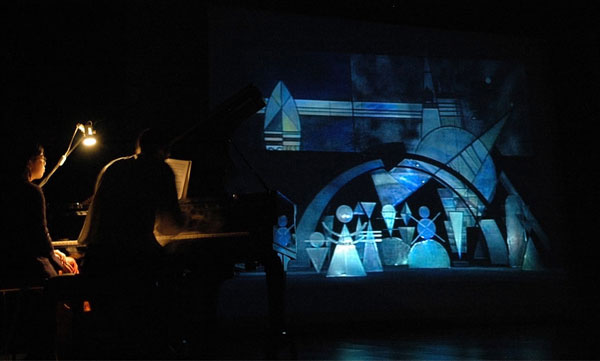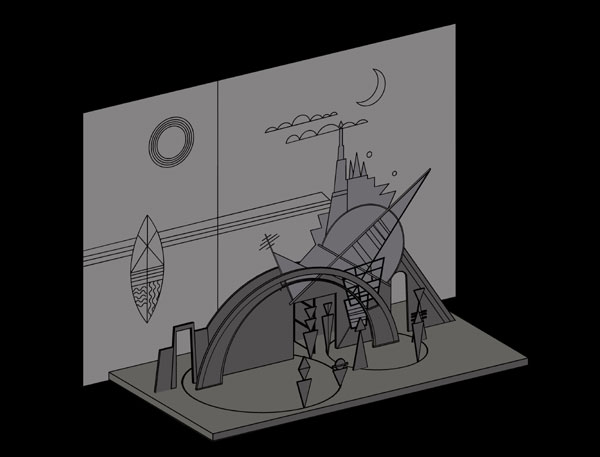|
The useful documentation for Kandinsky's production of Pictures
at an Exhibition is distributed throughout a large range of museums and archives in different countries. This has to do with Kandinsky's own biography, as well as with the vast historic and artistic background of this production. I will mention here some key points of my research on this piece.
As mentioned in the previous article,
the musical composition originated from
an exhibition of paintings and sketches
by Viktor Hartmann. The work of this
largely unknown artist has been the
object of study by art historian
Natalia Mutia; it gives a closer look
into the relationship between Hartmann
himself and his artwork with
Mussorgsky. The interesting chain of
inspiration picture-music-picture that
led to the final production of Pictures at an Exhibition,
stands in parallel with the long and
rich evolution of ideas about
color-music. The exhibition Musicircus:
Masterpieces from the Centre Pompidou
Collection, held from April 2016 to
July 2017 in the Centre Pompidou-Metz,
puts Kandinsky's work in this larger
perspective.
As for Kandinsky's own sketches for Pictures,
they are conserved in the Kandinsky
Library at the Centre Pompidou, Paris,
along with the score, annotated in 1928
by Kandinsky's assistant, Felix
Klee (son of Paul Klee), and several
other documents and articles about the
premiere of the production. Copies of
certain sketches exist in the Wahn
Castle Theatre Archive of Cologne
University (TWS). In my exchange with
the curator of the graphic arts
collection, Gerald Kohler, I learned
that the first director of the archive,
Carl Niessen, was interested in
Kandinsky's work and asked him in
person to make a copy of the sketches
for the archive.
A
further field for research is the
Bauhaus, where Kandinsky taught, a
school with an undeniably unique spirit
and atmosphere. In my discussion of Pictures with Michael Siebenbrodt, director of the Bauhaus-Museum Weimar, he pointed out that festivals organized (often held in theatres) by the Bauhäuslers—such as the Lantern Theatre, the Dragon Festival or the Kite Festival—served as a central principle for their education, almost like semester exams. During these large festivities (up to 4000 hand-painted postcards and invitations!), students and masters alike presented some of their works and ideas from the school's workshops. Just to name a few of the theatrical projects at the Bauhaus in these years: Totaltheater,
by Walter Gropius (1926/1927); Sketch
for a Score for a Mechanised Eccentric, by László Moholy-Nagy (1924); and Mechanical Theatre,
by Andor Weininger (1926-1928).
And certainly not least: Oskar
Schlemmer, head of the Bauhaus stage.
His work is important for the
reconstitution of the scene Market of Limoges, the
only section of the production's
music where Kandinsky introduces a
dance with actual actors. Little is
known about its original choreography
but the forms recall several costumes
from Schlemmer's signature Triadic
Ballet. Schlemmer created the
famous costumes for his
"ballet" by taking into
consideration the physical
possibilities of the human figure and
accentuating one or another part of the
body or its movement. I am thinking
here of one of Schlemmer's iconic
paintings, Tänzerin - Die Geste,
of 1922-23. A large collection of his
drawings can be found at the
Bauhaus-Archiv in Berlin. There is also
a backdrop for one of Kandinsky's
scenes that looks like a city map and
evokes the relationship between figures
and space in Schlemmer's paintings.

Photo of the 1983 reconstruction workshop: The Bogatyr Gates (In the Capital in Kiev).
From the archive of Martin Rupprecht.
In fact, the reconstruction of Pictures at an Exhibition done in Berlin in
1983 was presented on a double bill with Triadic Ballet. But while the
latter has been reconstructed several times, Kandinsky's production has
officially been brought to the stage only once. The work of reconstruction
was initiated by two professors, Martin Rupprecht and Horst Birr, at the
Berlin University of the Arts, as a workshop for students. Indeed, the piece
has great didactic potential since the stage design doesn't merely support
the actor, but is the actor, i.e. the bearer of the dramaturgy. The
reconstruction team tried mostly to use the same techniques as those used
in 1928 and to stay faithful to the original production.
What follows is the link to the film of the historic 1983 reconstruction,
which I used for my research and share here from my personal archive.
A true spectacle for the eyes. Filmed in the 1980s, it presents some curious
glitches and a specific color texture. For example, in the Ballet of
Unhatched Chicks you will see the moving lights producing a colored tail,
like a comet. That is only due to the camera and doesn't happen in the
show. The same happens with the sound where crackling occurs:
https://drive.google.com/file/d/1Rscioh-8YL50G_7JZ5dPmxJ7k
-QMM25u/view?usp=sharing
Note that for my own part, if the piece should one day be reconstructed
again, I would propose a different solution for the last scene, The Bogatyr
Gates (In the Capital in Kiev). Kandinsky didn't actually show in his
sketches the role the figurines would play in the production. In the
previously mentioned notations Felix Klee made in the score, the figurines
are divided into two groups, marked III and IV in a p. 33 pencil drawing.
Both there and two pages later, it is indicated that these two groups are
rotating. After I did my research on the piece in my time at the Moscow Art
Theatre School, I worked out a more complex structure for the
scenography. This is my 3-dimensional visualization of it.

The author's 3-D visualization for the final scene of
Kandinsky's Pictures at an Exhibition.
The figurines are fixed on two turntables installed on a platform. As the
turntables rotate one way, the figurines rotate in the opposite direction so
that they always maintain a frontal position in relation to the public. Thus
choreographed, the audience sees them enter the stage through the blue
arch and exit out the two lateral doors. Besides being an explanation for the
notes in the score, in my eyes this solution better reflects the triumphal and
festive scene, marked "maestoso" by Mussorgsky, by adding a rhythmical
touch to one of the longest scenes of the show. The geometrically shaped
figurines—the "citizens of the abstract world," as Kandinsky called them in
his treatise, Concerning the Spiritual in Art—join in the final scene as if for
the curtain call. It has to be mentioned that this solution requires a larger
stage and a more complex set construction.
In January of 2019, the reconstruction was presented again, as in 1983, at
the Academy of Arts in Berlin, on the program of the festival for the 100
-year anniversary of the Bauhaus, Bauhaus 100. I had the chance to assist
director Horst Birr at the installation and performance. The air was thick
backstage. The discreet sound of around 15 people's footfall and the quick
set changes filled the darkness and could be heard from the auditorium
almost like the living heartbeat of a painting.
Again and again I wonder about the capacity of this stage play to drive
artistic and musical sensibility. Horst Birr told the young stagehands, who
were the hidden actors: "You must sing along, you must crawl inside the
music!"("Ihr müßt mitsingen, ihr müßt in die Musik reinkriechen.") It
reminds me of the well-known theatre injunction: "With feeling!" ("Mit
Gefühl") which can often be given as a set or light cue. But in Kandinsky's
play, this "feeling" receives an allnew level of importance, since indeed, the
scenery plays the main role. The movement of the scenery had to be
smooth and musical. The importance of this feature stood out specifically
because of a curious technical detail of the reconstruction, namely the
installation of a classical fly rope-system on the stage, basically building a
theatre in the theatre. In fact, the stage of the Academy was already
equipped with motorized fly facilities, but the rumbling and the abrupt,
mechanized movement of the motor switching on and off was simply
unacceptable for the play.
With this ironic circumstance, where an avant-garde production refuses the
industrial capacities of its theatre, I conclude my brief description of Pictures at an Exhibition.
|